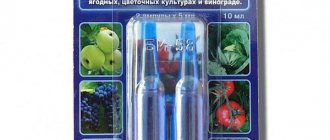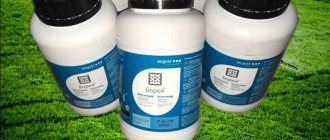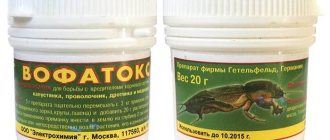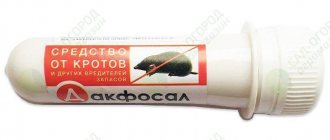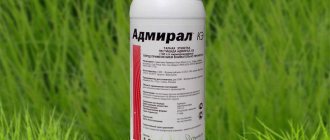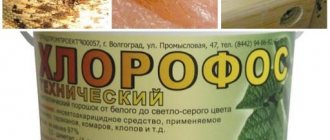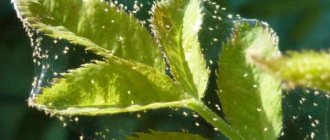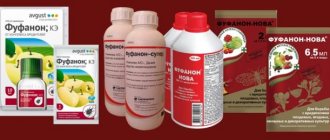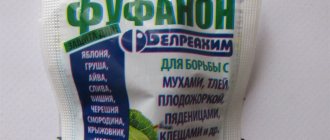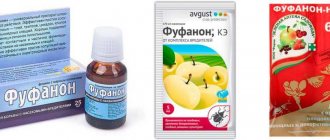Home / Preparations and fertilizers
Back
Published: 06/20/2019
2
Rate this post
The drug Borey, produced in the form of a concentrated suspension, is capable of protecting crops from many pests. The two-component base allows you to quickly destroy the entire colony of dangerous insects and provides a long-lasting effect even after a single treatment. Gardeners need special precautions and knowledge of the nuances of application on various crops due to the toxic composition of the insecticide.
- 1 Spectrum of action 1.1 Advantages of the drug
- 3.1 Reviews about the drug
Purpose of the drug
Destroys sucking and leaf-eating harmful insects, including secretive ones. Effective against insects resistant to pyrethroid insecticides and FOS. Acts quickly and has long-lasting protection. A drug with a systemic effect, it affects pests by contact and intestinal type. Resistant to prolonged sunlight and elevated temperatures.
"Borey" is intended for use on main agricultural crops, as well as in areas where locusts have appeared.
Mechanism of operation
Imidacloprid, from the class of neonicotinoids, has systemic activity; the substance penetrates through leaf and stem surfaces and through roots, affects the central nervous system of pests, blocking the functioning of nerve fibers. Lambda-cyhalothrin, from the class of synthetic pyrethroids, remains on the leaf surface, but is effective not only against insects, but also against phytophagous mites.
“Borey” inhibits the transmission of nerve impulses, insects are destroyed both when the solution comes into contact with them, and as a result of eating the sprayed plants. Double action allows the product to confidently destroy insects that are located on the lower surface of foliage and in hard-to-reach places.
Expert opinion
Zarechny Maxim Valerievich
Agronomist with 12 years of experience. Our best country expert.
Ask a Question
The action of the insecticide begins almost immediately after the pests appear in the body; they cannot feed and die within 1 day. "Borey" protects plants for 2-3 weeks.
Release form and active ingredient
Borey is produced by the famous domestic chemical enterprise "August". The insecticide is produced in the form of a concentrated emulsion. Packaging in containers of 1 liter. The concentrate must be diluted in water. After the working solution is ready, you can detect a slight specific smell.
As mentioned above, this is a bicomponent drug, that is, it contains two main components - imidacloprid and lambda-cyhalothrin. The second, by the way, is the main active component of another insecticide - Break.
The active components of the pesticide allow you to quickly destroy parasites, even those that are hidden from the human eye.
Imidacloprid accounts for 15% of the total drug volume. The substance penetrates into the structure of plants and accumulates there. When the parasites begin to chew on the crop, the substance penetrates the insect’s intestines and “incapacitates it.”
Lambda-cyhalothrin accounts for 5% of the total volume of the drug. This is a synthetic substance that affects the nervous system of the parasite. It is also worth noting that this substance is highly effective in the fight against ticks.
Thus, thanks to the combination of these components, the effect on the parasite is carried out both externally and internally. The drug destroys parasites, and then has a protective effect for a long time.
Instructions for use of the insecticide "Borey"
Dosage rate in agriculture (in l per ha):
- wheat, barley, rapeseed – 0.08-0.1;
- beets – 0.1-0.12;
- pastures – 0.1-0.15;
- peas – 0.12-0.15;
- potatoes, tomatoes – 0.08-0.12;
- onions from thrips - 0.12-0.14, from flies - 0.2-0.25;
- carrots from psyllids - 0.12-0.14, from flies - 0.2;
- cabbage – 0.1-0.14;
- apple tree, grapes – 0.3;
- wheat – 0.1.
See also
List of top 7 drugs with flonicamid, its description and mechanism of actionRead
The frequency of spraying with Borei is 2, the consumption when treating seedlings is 100-200 l, for adult plants - 200-400 l per hectare, for trees and grapes - 800-1500 l, when spraying from an airplane - 25-50 l. The waiting period before harvesting is from 10 to 38 days. You can work on treated areas a week after spraying.
AgroChemService
To goods for agricultural producers
imidacloprid + lambda-cyhalothrin (150 g/l + 50 g/l) Two-component contact-system insecticide for the protection of grain crops from a complex of pests, including hidden ones
The pests were blown away by the wind!
Advantages:
- The only ready-made formulation of a mixture of neonicotinoid and pyrethroid on the market
- two active substances from different chemical classes with different mechanisms of action
- combination of speed and duration of action
- high systemic activity
- destruction of pests inside the stem and on the underside of leaves
- high efficiency against pest populations resistant to pyrethroids and organophosphorus compounds
- effective control of vectors of viral cultures
- resistance to prolonged exposure to intense sunlight and high temperatures
Purpose:
- a combined drug with two different mechanisms of action to combat a wide range of pests on grain crops.
Active ingredients:
- imidacloprid, 150 g/l and lambda-cyhalothrin, 50 g/l.
Preparative form:
- suspension concentrate.
Characteristics of active ingredients:
- Imidacloprid belongs to the class of neonicotinoids (chloronicotinyls), exhibits systemic activity, and has a contact-intestinal effect on many types of gnawing and sucking harmful insects. Lambda-cyhalothrin is a synthetic pyrethroid; it has a contact-intestinal effect, but, unlike the vast majority of pyrethroids, it is also effective against herbivorous mites.
Range of action:
- The insecticide destroys all the main pests of grain crops, including: bugs, pine beetles, aphids, bread beetles, thrips, flea beetles, and leafhoppers. A remarkable property of Boreas is that, thanks to its systemic activity, it also affects hidden pests, such as stem sawflies, as well as phytophages that feed on the underside of leaves and other parts of plants that the working solution may not reach.
Mechanism of action of the drug:
- The active ingredients of the insecticide work differently, so their combination in one formulation leads to high results.
- Imidacloprid acts as an antagonist of postsynaptic receptor binding in the nervous system of pests. It has systemic translaminar activity, penetrates plants through leaves, stems and roots, is distributed throughout the parenchyma and moves along the xylem.
- Lambda-cyhalothrin is a contact action inhibitor of oxidative phosphorylation. It remains outside on the treated plant surface.
- Boreas quickly suppresses the transmission of signals through the central nervous system of pests. Insects are affected both when sprayed and when feeding on and inside the treated plant.
Impact speed:
- a few minutes after the drug enters the body of the pests, they stop feeding and die within 24 hours.
Period of protective action:
- The effect of Boreas lasts on average 14 - 21 days.
Features of the drug:
- Thanks to its systemic action, Borey destroys populations of pests resistant to pyrethroids and organophosphorus compounds. The drug combines rapid action (the so-called “knockdown” effect) with a long period of protective action and is resistant to prolonged exposure to intense sunlight. Due to the effective combination of components, Borey is more economically profitable than tank mixtures of organophosphorus and pyrethroid drugs.
Phytoxicity, crop tolerance:
- At recommended consumption rates, the drug is non-toxic to plants.
Restrictions:
- Borei is highly dangerous for bees (the border protection zone for bees is at least 4 - 5 km, the flight of bees is limited to at least 120 - 140 hours). The use of the drug in the water protection zone of fishery reservoirs is prohibited.
Storage conditions:
- The drug must be stored in warehouses specially designed for pesticides, in hermetically sealed, undamaged original packaging at a storage temperature of minus 10 to plus 35 °C.
Package:
- bottles of 1 liter.
Culture
| Pest | Consumption rate, l/ha | |
| Wheat | Bug bug, aphids, bread beetles, wheat thrips, flea beetles | 0,08 — 0,1 |
| Barley | Pjavitsa, Swedish flies, wheat thrips, stem sawflies, aphids | 0,08 — 0,1 |
Processing frequency:
- Double processing is allowed.
Recommendations for use:
- Wheat crops against flea beetles must be sprayed at seedlings, against other types of harmful insects - during the growing season of grain crops, when pests appear on the field in quantities exceeding the economic threshold of harmfulness.
- The drug can be used 1-2 times per season, observing the waiting period of 28 days.
Preparation of working solution:
- the working fluid must be prepared immediately before spraying. First, it is recommended to prepare a stock solution of the insecticide. To do this, mix the amount of the drug calculated for one filling of the sprayer with water in a separate container until a homogeneous suspension is obtained, not exceeding the concentration of 0.2 liters of the drug per 1 liter of water. After this, fill the sprayer tank halfway with water, turn on the mixer and pour the borea stock solution into the tank. Then, without turning off the mixer, you need to add water to the tank until it is full.
- The working solution must be used on the day it is prepared.
Compatibility:
- Borea can be used in tank mixtures with fungicides, for example, Kolosal. However, before using a particular mixture, it is necessary to check its compatibility of components. Borea should not be mixed with pesticides that are highly alkaline or highly acidic.
Working fluid consumption:
- when spraying on seedlings against flea beetles - 100 - 200 l/ha, in other cases - 200 - 400 l/ha.
Waiting period:
- 28 days.
Time limits for safe exit to treated areas:
- for mechanized work – 3 days.
Hazard Class:
- 3rd hazard class (moderately hazardous compound), 2nd hazard class for persistence in soil.
First aid for poisoning:
- When the first signs of poisoning appear, it is necessary to remove the victim from the area of exposure to the toxic substance, carefully remove contaminated clothing and a respirator from the victim, avoiding contact of the drug with the skin or respiratory organs.
- in case of contact with skin, remove the drug with a piece of cloth, cotton wool or cloth, avoiding rough rubbing of the skin, and then wash the contaminated area with soap and water.
- In case of contact with eyes, immediately rinse eyes with open eyelids with plenty of clean running water.
- in case of accidental ingestion, immediately give several glasses of warm water with activated carbon to drink (at the rate of 1 g of sorbent per 1 kg of body weight), and then induce vomiting by irritating the back wall of the pharynx. Repeat the procedure several times to more completely remove the drug from the body.
- After providing first aid, consult a doctor immediately.
Information for the doctor
- Treatment is symptomatic. There are no specific antidotes.
If necessary, consult the toxicology center: 129010, Moscow, Sukharevskaya Square, 3. Moscow Research Institute of Emergency Medicine named after. Sklifosovsky. Toxicological information and consultation center. Tel., fax: (495) 921-68-85 (24 hours a day).
Safety precautions for transportation and use:
- transportation of the drug is carried out by all types of vehicles in accordance with the rules for the transportation of dangerous goods in force for this type of transport.
When using, it is necessary to comply with the requirements and precautions in accordance with GOST 12.3.041-86 and SanPiN 1.2.1077-01 “Hygienic requirements for the storage, use and transportation of pesticides and agrochemicals”, Moscow, 2002. Working with the drug without personal protective equipment is prohibited. skin, eyes and respiratory organs.
Methods for neutralizing spilled pesticide:
- To neutralize a spilled drug, cover the contaminated area with absorbent materials (sand or sawdust) until completely absorbed. Collect contaminated sorbents in containers for subsequent destruction. The spill area must be neutralized with a 3-5% solution of soda ash and washed with water.
- Methods of destruction or disposal of pesticides: pesticide residues and contaminated sorbents are subject to removal and thermal destruction in places approved by territorial environmental authorities and State Sanitary and Epidemiological Supervision agencies.
- Methods for destroying pesticide containers: pesticide containers are subject to removal and thermal destruction in places approved by territorial environmental authorities and State Sanitary and Epidemiological Supervision agencies.
- The prepared working fluid is pumped into filling containers and delivered to the treatment sites. In the absence of mechanization means, the preparation of working solutions of the drug is not allowed. When preparing the working solution and refueling the sprayers, spillage of the working fluid is not allowed. The working solution must be used on the day of preparation. After treatment, be sure to wash and dry the sprayer.
Restrictions on transportation, use and storage of the pesticide:
- transportation and storage of the drug together with food products and animal feed is strictly prohibited.
- The use of pesticides on private farms and by air is prohibited.
- The use of the drug in the sanitary zone of fishery reservoirs is prohibited.
Recommendations for the protection of useful flora and fauna:
- the drug is highly dangerous for bees (hazard class 1).
- The use of a pesticide requires compliance with the basic provisions of the “Instructions for the Prevention of Bee Poisoning by Pesticides” (Moscow, 1989), including preliminary notification of local apiary owners about the nature of the plant protection product planned to be used, the specific timing and areas of its application, and the prevention of bees from visiting treated areas before the due date.
It is prohibited to treat flowering entomophilous crops during the active summer of bees. The following restrictions must be observed:
- Plants should be treated at a wind speed of no more than 1 - 2 m/s in the morning and evening hours, but it is acceptable during the day in cloudy, cool weather, when bees do not fly out of the hive;
- border protection zone for bees - at least 4 - 5 km;
- limiting the flight of bees - at least 120 - 140 hours.
Fisheries assessment:
- Due to the toxicity of the drug to aquatic organisms, its use in the water protection zone of fishery reservoirs is prohibited.
To goods for agricultural producers
Safety precautions
In terms of toxicity, "Borey" belongs to class 3 for humans and 1 for bees. It cannot be used on flowering trees, grapes and other crops; it is also necessary to observe the bee flying zone - 4-5 km from apiaries, and notify beekeepers 4-5 days before treatment.
To ensure safety, work with the insecticide and its solution in protective clothing, gloves, goggles and a respirator with a filter. Do not remove until work is completed, do not drink, eat or smoke.
If the insecticidal solution gets on the skin, rinse it off with water; you should also rinse your eyes thoroughly if they get splashed. Rinse with water and medicinal charcoal if the solution gets into the stomach. If the condition worsens, consult a doctor.
Application of pesticide
The instructions for use indicate that against seedling parasites (flea beetles, etc.) the drug is used on seedlings, with other insects that infect an already developed crop being fought during the growing season.
If locusts are constantly active in the area, then treatment is carried out during the development of the larvae. Borei can be used twice per season, in some cases only once. The period between treatments is at least a month when spraying grain crops, tomatoes, cabbage and carrots; when spraying apple trees, potatoes and beets, the waiting period is 3 weeks; when processing rapeseed – 40 days; onions – 3 weeks; grapes - 2 weeks.
It is not recommended to use this insecticide on pastures due to the danger of killing bees. This drug is deadly to honey insects. The protection zone during processing is 4-5 km. After spraying the crops, honey insects should not be allowed into the work area for 140 hours. When spraying with Boreas, if there are beekeepers in the area, then it is necessary to warn them in advance.
Compatibility with other substances
"Borey" is allowed to be combined in mixtures with fungicides for the treatment of grains with the preparations "Kolosal" and "Kolosal Pro", "Demerta", "Eraser Extra", "Eraser 100", "Ballerina", for the treatment of rape - with the preparation "Galion" , beets - with “Biceps 22” and “Biceps Guarantor” products. Can be combined with mineral fertilizers and growth regulators.
If the compatibility of the active substances of the drugs is unknown, testing must be done before mixing: mix a small amount of a solution of both products and check the chemical reaction. If there is no change in color, consistency, temperature, sediment does not fall out and lumps form, the products can be mixed.
See also
Instructions for use and composition of Fastak, dosage of insecticide and analoguesRead
Storage rules
The insecticide "Borey" is stored for 3 years from the date of production. Storage conditions: dry, dark and ventilated area. The concentrate must be stored in original packaging. Can be kept together with fertilizers and other pesticides; food, feed, medicines and household products are excluded.
After the end of the shelf life, the drug must be disposed of. Use the entire solution on the day of preparation; it can be stored for only 1 day. After this, there is no point in using it, as it loses its effectiveness.
Analogues of the product
You can replace the drug “Borey” with products with a similar purpose and effect: “Gunner Duo”, “Strike BT”, “Greenfort Il 200”, “Anticolorad”, “Borey Neo”, “Akinak”. They can be used in the fields and gardens of agricultural enterprises, in vegetable gardens and in private gardens.
“Borey” is an insecticide used in agriculture on many crops to treat them against common types of pests. Capable of destroying insects belonging to different families, even secretive ones or resistant to pyrethroid pesticides and FOS. The advantage of the insecticide is that it does not lose its effect when exposed to sunlight or high temperature, that is, it can be used to treat plants in the summer, in the heat. “Borey” is distinguished by its fast action and long-lasting protective effect; pests do not appear or breed on treated crops for 2-3 weeks.
Spectrum of action
The product is used to protect and control pests of cereals, fruit trees, vegetables and vineyards. For potatoes it is used as an effective remedy against the Colorado potato beetle. The components that make up the drug Borey contribute to the death of such dangerous insects as fleas, aphids, thrips, bedbugs, flies and moths. The effectiveness of the application is due to the action of 2 components:
- imidacloprid (150 g/l) penetrates plant tissue and prolongs the protective function of the drug up to 28 days after treatment;
- Lambda-cyhalothrin (50 g/l) causes a rapid paralytic effect. The death of insects occurs within 24 hours from the moment of contact with the insecticide.
In addition, lambda-cyhalothrin is not destroyed by exposure to sunlight and inhibits the growth of larvae. These properties allow the drug to successfully fight pests at different stages of development and destroy secretly living insects.
